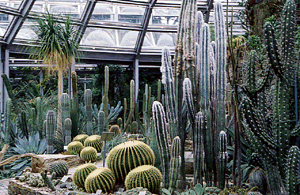Greenhouses - House I
|
A selection of cacti showing the morphological diversity of Cactaceae is grouped around a center piece of an over 100 year old Echinocactus grusonii. This species was only described in 1885 by the Berlin nurseryman Hildmann. The leaf-bearing cacti of the genus Pereskia are present with several species, of which a large specimen of Pereskia grandifolia produces its rose-like flowers all summer. A columnar cactus (Trichocereus thelegonus) devoid of woody tissue grows snake-like among its erect relatives. Important other genera dominating the landscape are Agave, Dasylirion, Yucca, and Beaucarnea (Agavaceae). Pachycereus and Neobuxbaumia as well as Echinocactus dominate among the Cactaceae. Crassulaceae are represented by Echeveria, Dudleya, and Sedum. The limestone areas of Mexico are represented by a selection of plants including cacti (Myrtillocactus, Mammillaria, Ferocactus, and Astrophytum), Dasylirion longissimum, and several Echeveria species. Plants of the Sonoran desert, the specimens here all grown from seed, include Agave, Opuntia, and Fouquieria. Other geographical groups comprise plant species of the Andes of Peru, Bolivia, Argentina, and Chile with numerous columnar cacti (Espostoa, Trichocereus, Browninia, Cleistocactus) now 30-40 years old. The stout candelabriform Stetsonia coryne from the Chaco region, and Opuntia brasiliensis with its peculiar leaf-like, deciduous stem segments are other remarkable plants. On the gallery, a display of species of cacti in alphabetic order of genera, some "Berlin cacti" (named for or by Berlin botanists or nurserymen), and convergent forms of cacti and other succulents are planted in the glass show cases. Up here, the succulent, night blooming lianas with some of the largest flowers among cacti, Hylocereus undatus and Selenicereus pteranthus (the princess of the night) are climbing under the roof. B. Leuenberger |
Continue the tour of the greenhouses...

 Succulent plants and xerophytes of the New World are shown here in several geographical groups. These are complemented by displays of noxious succulents weeds (pest prickly pears etc.), useful succulents like tuna (Opuntia ficus-indica), the pulque Agave, tequila Agave, and others. Three species of cacti grown in hedges or living fences are shown here planted accordingly. Photo left: View of the cactus and New World succulents display.
Succulent plants and xerophytes of the New World are shown here in several geographical groups. These are complemented by displays of noxious succulents weeds (pest prickly pears etc.), useful succulents like tuna (Opuntia ficus-indica), the pulque Agave, tequila Agave, and others. Three species of cacti grown in hedges or living fences are shown here planted accordingly. Photo left: View of the cactus and New World succulents display.